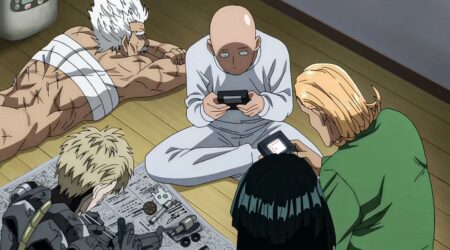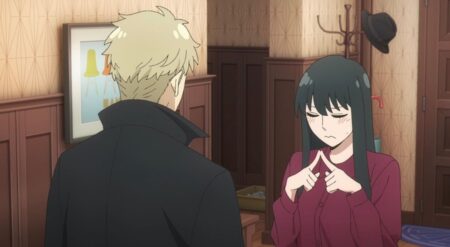There’s a significant legacy behind the latest Netflix anime series, TP Bon. Directed by Masahiro Ando, the original series is written and illustrated by Fujiko Fujio. The duo of Hiroshi Fujimoto and Motoo Abiko has created some of the most iconic figures in Japanese media, most notably the titular character of Doraemon. TP Bon, known initially as Time Patrol Bon, ran from 1978 until 1986. And now, to varying results, the manga is getting a long-awaited adaptation through Studio Bones.
There are degrees of familiarity with the series, partly due to our understanding of time travel stories. A young, unassuming teenager, Bon (Akihisa Wakayama), — is picked by a mysterious time traveler, Ream (Atsumi Tanezaki), and becomes an apprentice. The duo works under a jurisdiction that assigns them tasks that require them to travel throughout time to save individuals relevant to history. However, as in other time travel-oriented media, from Doctor Who to Loki, there are rules on how much they can tinker with. Beholden to those rules, Bon and Ream must work together to save who they can under increasingly dire circumstances.
The adherence to the historical nature of the series is both a hindrance and a benefit to TP Bon. There’s a charm to the classical character designs, with rounded, simplistic features and exaggerated reactions. These designs work perfectly well for our leads, Bon in particular, who self-describes himself as perfectly average and happy to be so. Other supporting characters suffer more from this style due to the level of sameness that infects characters who only appear on an episode basis.
The animation is also static, most notably in Episode 3, where Bon and Ream travel to 2592 B.C. to save a man buried alive in a pyramid. The foreground and background movements fail to render cohesively, leaving it feeling dated rather than simply adopting and honoring the Fujiko Fujio style. We can look no further than 2023’s Pluto and how it could pick from elements of the original Astro Boy to infuse it with something timeless despite being a modern story. The tone and style of TP Bon flounders in comparison.
The tone isn’t helped by, at times, the aggravating nature of its protagonist. While Bon goes through a tried and true emotional journey, his introduction is irritating. The same can be said for Buyoyon, a pac man ghost-looking blob that follows them throughout time. The combination of both is often loud and abrasive, creating a significant tonal dissonance when it comes to the darker elements of the series.

Those darker moments make the series stand out, even when it drags its feet due to its episodic “assignment of the week” procedure. We’re struck with this immediately in Episode 1. Bon accidentally causes the death of his friend, pushing him over the railing of his apartment home. Said friend had already been miserable about having gotten zero points on a test, falling with said paper in hand. We watch as the blood from his injuries spreads on the ground, seeping through the paper until the red of his score is encased by it. It’s grim, touched with the blackest of comedy, before Bon is introduced to time travel, and his friend’s life is spared because of it.
The series refuses to pull its punches with violence, though it’s never used for shock value. Instead, we see it come naturally in moments like when they travel back to the samurai world. The battle of Okinawa in 1945 delivers requisite brutality as we see the bodies of soldiers strewn across the battlefield. Said violence is all the most potent due to the childlike humor. TP Bon is an amalgamation of good ideas that don’t always translate to the screen. For every stunning, cherry blossom-filled backdrop or moment where Bon and Ream realize they’re too young to witness such endless cruelty, it’s counteracted with a less-than-stellar joke or stiff animation.
Certain classic elements work, specifically the jaunty and lively score by Michiru Ōshima. The composer weaves together playful notes that help fill in the gaps in the story, creating something singular compared to other modern series. It helps give stakes to moments that lack initial impact. While the character animation is charming, not every background creates the necessary depth. Certain moments, such as the characters against vast seas or traveling through space, deliver the epic scope of their many worlds. Some, such as the samurai storming a field, fail to strike the necessary level of excitement.
The series needs either a stronger, more cohesive marriage of its competing tonalities or a direction that pivots into one single direction. Make it classical and playful, stripped down of the dizzying action of modern action. Or, instead, push into the adventerous spirit and create something fresh while also honoring the source material. The opening is one of the best aspects of the series because it quickly establishes a would-be atmosphere of pure science fiction.
The biggest issue in TP Bon is that it’s all relatively dull and slow-moving for a series surrounding time travel. The stakes are shockingly low, even when people’s lives are on the line. We don’t feel the impact like we should. While moments of the series are well done and characters grow throughout, it never delivers the big, emotional push necessary. Instead, the episodic nature slows the story down and makes for often tedius viewing. It’s fine. But the pieces available to the production should’ve ensured something greater than just fine.
TP Bon is available now on Netflix.
TP BON
-
Rating - 6/106/10
TL;DR
The biggest issue in TP Bon is that it’s all relatively dull and slow-moving for a series surrounding time travel. The stakes are shockingly low, even when people’s lives are on the line.








